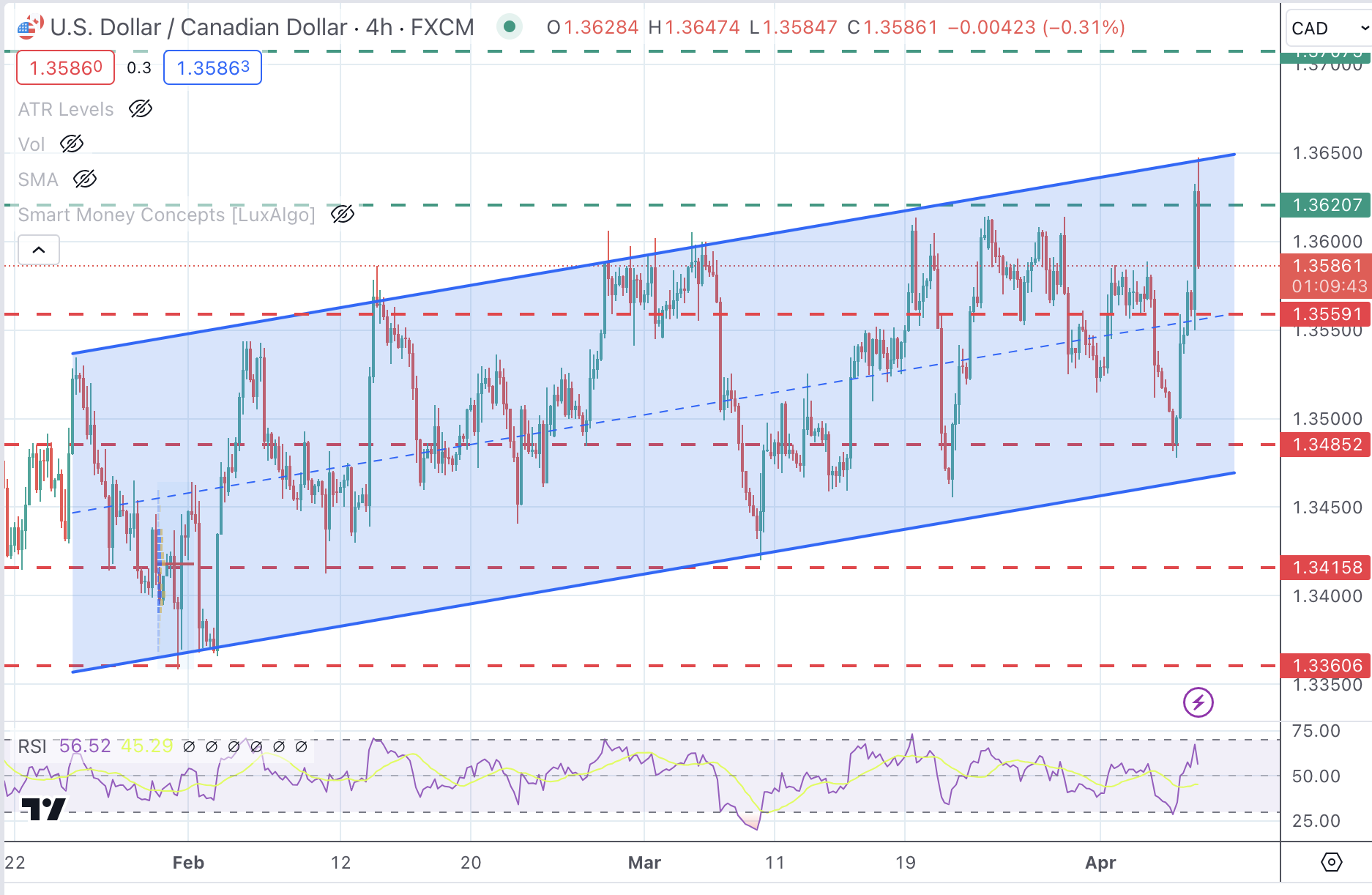- The US dollar appreciates and the Canadian dollar falls for the second day in a row.
- Strong US employment data boosts Treasury yields and US Dollar.
- In Canada, strong Ivey PMI data eases bearish pressure on the Canadian Dollar following disappointing jobs numbers.
He Canadian dollar (CAD) extended its losses on Friday, after Thursday's decline, to test new lows so far this year. The combination of a stellar US jobs report and weak Canadian jobs numbers have undermined investor confidence in an already weak Canadian dollar.
Data released by the US Department of Labor on Friday shows that the US economy created jobs well above expectations in March. Furthermore, wages continued to grow at a steady pace, well above levels consistent with the Federal Reserve's (Fed) 2% inflation target.
These figures pour cold water on market hopes for interest rate cuts in June and support the central bank's hardline party, which advocates delaying and reducing the easing cycle. This has pushed up US yields, dragging down the US dollar with them.
In Canada, net employment levels fell in March contrary to expectations. However, the negative impact has been offset by the strong improvement in the March Ivey PMI, which has provided some support to a weakened Canadian dollar.
Daily Market Moves Summary: USD/CAD Continues to Fall as US NFP Beats Expectations
- The Canadian dollar has lost more than 0.5% over the past two days, reversing last week's gains and reaching its lowest price since December 2023.
- US Nonfarm Payrolls increased by 303,000 in March compared to 270,000 in February, well above the 200,000 expected by market experts.
- Average hourly earnings have increased at a rate of 0.3% month-on-month and 4.1% year-on-year from 0.2% and 4.3% respectively in February.
- The Canadian Ivey Purchasing Managers' Index has improved to 57.7, its best reading in the last 12 months, from 53.9 in February.
- Earlier, Canadian employment data disappointed investors with a decline of 2,200 in March after an increase of 40,700 in February. The market expected an increase of 25,000.
- On Thursday, Fed Powell reiterated that the central bank needs more time to decide on rate cuts, while Fed Kashkhari warned that there might not be any rate cuts this year, sending the dollar higher.
Price of the Canadian Dollar today
Below is the percentage change of the Canadian Dollar (CAD) against the currencies listed today. The Canadian dollar appreciated against the Japanese yen.
| USD | EUR | GBP | CAD | AUD | JPY | NZD | CHF | |
| USD | -0.06% | 0.08% | 0.32% | 0.10% | 0.21% | 0.16% | -0.15% | |
| EUR | 0.05% | 0.10% | 0.36% | 0.15% | 0.26% | 0.21% | -0.11% | |
| GBP | -0.08% | -0.14% | 0.23% | 0.03% | 0.14% | 0.08% | -0.24% | |
| CAD | -0.29% | -0.35% | -0.23% | -0.19% | -0.08% | -0.13% | -0.44% | |
| AUD | -0.09% | -0.15% | -0.01% | 0.23% | 0.12% | 0.07% | -0.26% | |
| JPY | -0.22% | -0.27% | -0.15% | 0.06% | -0.13% | -0.05% | -0.38% | |
| NZD | -0.17% | -0.21% | -0.09% | 0.14% | -0.07% | 0.04% | -0.34% | |
| CHF | 0.14% | 0.09% | 0.24% | 0.46% | 0.25% | 0.37% | 0.33% |
The heat map shows the percentage changes of the major currencies against each other. The base currency is chosen in the left column, while the quote currency is chosen in the top row. For example, if you choose the Euro in the left column and scroll down the horizontal line to the Japanese Yen, the percentage change that appears in the box will represent EUR (base)/JPY (quote).
Technical Analysis: USD/CAD has tested the resistance of the 1.3640 zone
Strong US employment data has led USD/CAD to test an important resistance zone above 1.3620, which remains intact for now, as positive Canadian PMI data has eased bullish pressure on the pair.
Overall, the US dollar is moving within an ascending channel, with the price capped below the trendline resistance at 1.3640. Above, the next targets are 1.3710 and 1.3770. The channel's measured target is 1.3845. Support levels are 1.3560 and 1.3485.
USD/CAD 4-hour chart

Employment FAQs
How do employment levels affect currencies?
Labor market conditions are a key element in assessing the health of an economy and, therefore, a key factor in the valuation of currencies. A high level of employment, or a low level of unemployment, has positive implications for consumer spending and therefore economic growth, boosting the value of the local currency. On the other hand, a very tight labor market – a situation in which there is a shortage of workers to fill vacant positions – can also have implications on inflation levels and, therefore, on monetary policy, since a supply of labor Low labor and high demand lead to higher wages.
Why is wage growth important?
The pace at which wages grow in an economy is key for policymakers. High wage growth means that households have more money to spend, which often translates into higher prices for consumer goods. Unlike more volatile sources of inflation, such as energy prices, wage growth is considered a key component of underlying and persistent inflation, as wage increases are unlikely to be undone. Central banks around the world pay close attention to wage growth data when deciding their monetary policy.
How much do central banks care about jobs?
The weight that each central bank assigns to labor market conditions depends on its objectives. Some central banks have mandates explicitly related to the labor market beyond controlling inflation levels. The United States Federal Reserve (Fed), for example, has the dual mandate of promoting maximum employment and stable prices. Meanwhile, the only mandate of the European Central Bank (ECB) is to keep inflation under control. Even so, and despite the mandates they have, labor market conditions are an important factor for the authorities given their importance as an indicator of the health of the economy and their direct relationship with inflation.
Source: Fx Street
I am Joshua Winder, a senior-level journalist and editor at World Stock Market. I specialize in covering news related to the stock market and economic trends. With more than 8 years of experience in this field, I have become an expert in financial reporting.







